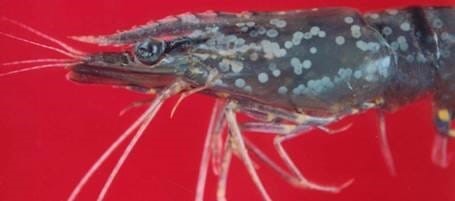The early identification of white spot syndrome virus (WSSV) in shrimp could be achieved with the naked eye, by utilising the light scattering properties of gold nanoparticles (GNPs).

The initial large-scale breakout of WSSV took place in the early 1990s
WSSV causes significant financial losses in shrimp farming. As there are no effective treatments for it, early detection is the only effective method of protection, but existing technology lacks the simplicity, ultra-sensitivity and efficiency required for this.
Visual inspection, electron spectroscopy, immunotherapy and molecular biology are the current approaches used to identify WSSV. The majority of existing detection methods are qualitative and unable to quantify the amount of white spot syndrome viral copies, notes Hussain Ahmed in Azonano. Although quantitative PCR (qPCR) can be used for statistical identification, the equipment is costly and the process is complex.
Gold nanoparticles are increasingly being employed in the development of physiological and biochemical sensors for the detection of biomolecules, ions and viruses. In the study, the pre-proof version of which has recently been published in Aquaculture the researchers created a gold nanoparticle-labeled dark-field counting approach for detecting the WSSV. First, antibodies against the virus were employed to interact with the 15-nanometer gold nanoparticles. Then pure probes consisting of mono-dispersed gold nanoparticles were treated with the virus specimen for a short period to produce a complex of WSSV and gold nanoparticles.
The researchers found that the 15 nm gold nanoparticles alone were undetectable in the dark field due to poor dispersion of light. However, each complex of WSSV and gold nanoparticles assumed a brilliant, gold, and elliptical shape under dark-field microscopy, making them countable with the naked eye.
According to Hussain, this approach is simple to implement since it only requires mixing gold nanoparticles with a specimen for a short period before dropping some of the solutions on a slide for naked-eye identification using a dark field microscope. It is also accurate and time-saving, with detection occurring within 30 minutes – four times faster than using qPCR.
By The Fish Site
Reference : https://thefishsite.com/articles/gold-can-speed-up-detection-of-white-spot-in-shrimp
“Domesticated Shrimp Postlarvae – The Key To Success”
See more:
- Forming a Leadership Group For The Global Shrimp Sector
- Demand is growing for natural astaxanthin for aquaculture feeds and this Hawaiian biotech company is poised to take advantage
- Colored LED Lights Can Influence Shrimp Growth, Water Quality In Biofloc Culture

 Tiếng Việt
Tiếng Việt 中文 (中国)
中文 (中国)